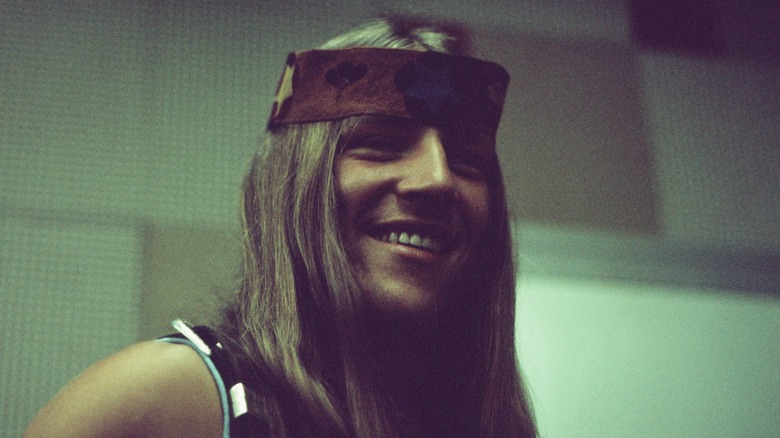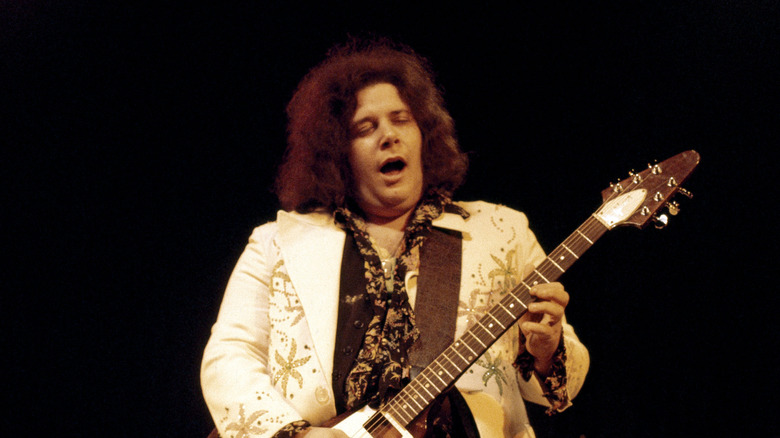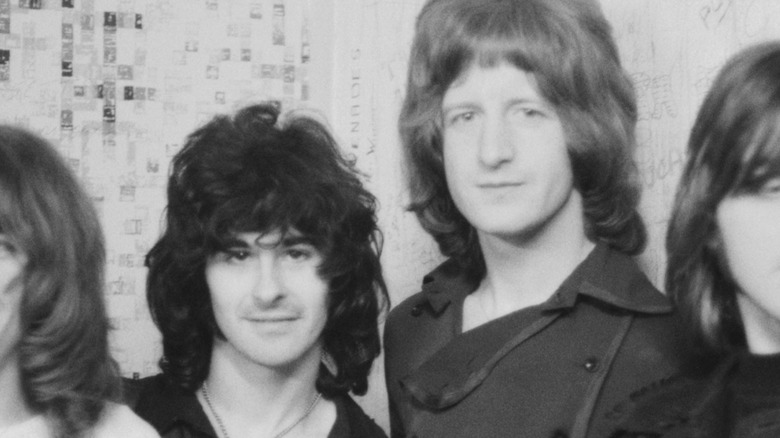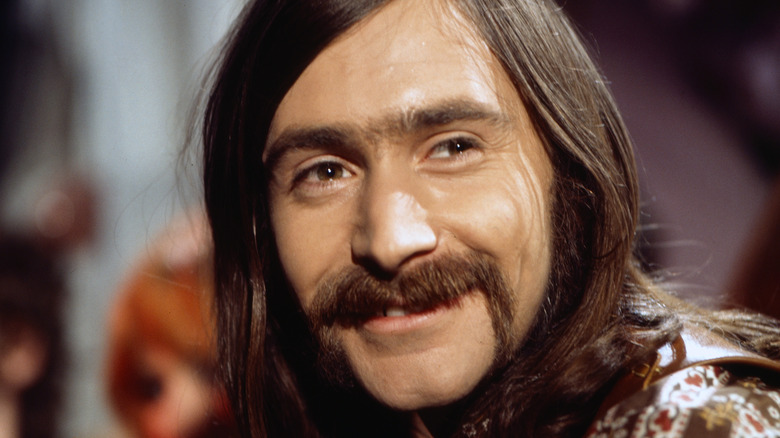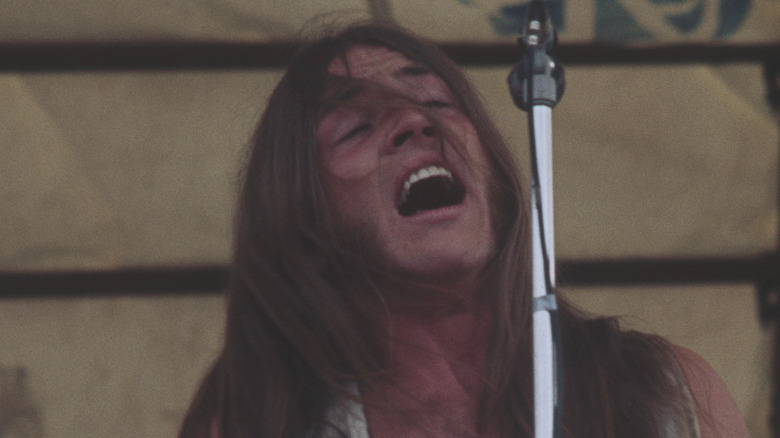Rock Stars From 1970 Who Should Still Be Famous Today
Following the trying and tumultuous 1960s, the calendar turned to 1970, which brought with it a sense of change and newness. The youthful counterculture of the previous decade was poised to sit atop the cultural mainstream, and it entrenched the decade's music scene: Hard rock, blues rock, power pop, proto-metal, and stadium-filling anthemic rock emerged as the dominant styles of the era. Those forms gave the world a generation of definitive rock stars, like Jimi Hendrix, Led Zeppelin's Robert Plant, and the Who's Roger Daltrey, among others.
There were so many preening, magnetic, and immensely talented rock stars that it made for a crowded marketplace. Many bands and solo acts made it to the top and got to enjoy only a relatively brief period of fame, fortune, acclaim, and adulation. Over time, those fleeting rock stars more or less faded from the collective memory, and that's somewhat unfair, because they had what it took to become some of the biggest rock stars when being one really meant something. Here are the breakout rock stars of 1970 that should still be household names five decades later.
Leslie West of Mountain
Leslie West could do both of the things that often made a rock musician into a rock star in the early 1970s: He could shred, and he could wail. West was the lead singer and a guitarist in the very hard and heavy blues rock band Mountain. Woodstock may not have actually turned a profit, but the iconic countercultural music event helped make Mountain and West respected and famous. Just months after the group played a set at the festival, its first single, "Mississippi Queen," entered the Hot 100 pop chart. Co-written by West, it soared to No. 21, and it showcased the skills of the band's frontman, whose penetrating and powerful vocals were matched only by his heavy guitar riffs.
While "Mississippi Queen" stuck around forever as a staple on classic rock radio, Mountain did not. Its next singles, "For Yasgur's Farm" and "The Animal Trainer and the Toad," didn't go anywhere near the Top 40, and the band routinely broke up and regrouped throughout the 1970s and 1980s. Hardcore fans still sought out West and his solo projects, but he didn't experience much commercial success. In 2011, complications from diabetes required a partial leg amputation, and West died at age 75 in 2020.
Tom Evans and Pete Ham of Badfinger
The Welsh band the Iveys found some minor success in the U.K. in the late 1960s, and then the Beatles came calling. The Iveys were the first band signed to the group's private Apple Records label. Afterward, they changed their name to "Badfinger" and recorded "Come and Get It," written by Paul McCartney for the soundtrack of fellow Beatle Ringo Starr's 1969 film "The Magic Christian." Released in January 1970, "Come and Get It" hit the top 10 in the U.K. and the U.S., and Badfinger got to work recording its first full-length studio album, "No Dice."
The four-piece band boasted two breakout stars: Guitarist Pete Ham and bass player Tom Evans, who took turns on lead vocal duties and also wrote songs. The group required that versatility to match its variable sound. In 1970, Badfinger released the poppy "Come and Get It," followed by the release of the hook-laden power pop jam "No Matter What," another top 10 hit. Album cut "Without You," a love ballad, was made more famous when covered by Harry Nilsson later that year. Badfinger had its last big hit in 1972, Ham's "Baby Blue," probably better known to modern audiences for its inclusion in the final scenes of "Breaking Bad."
Badfinger met a particularly somber end. The group fizzled out as the '70s progressed, and after some failed business dealings, managerial theft, and mental health issues, Ham died by suicide in 1975. Evans revived Badfinger for an ill-fated spell in the early '80s, and he also died by suicide in 1983.
Norman Greenbaum
When TV and movie soundtrack supervisors or commercial producers want to frame their project's plot in the early 1970s, evoke the hippie vibes of the era, or lend an air of religiosity, it's highly likely they'll license the use of "Spirit in the Sky" by Norman Greenbaum. It was rediscovered in the late 1980s after it fell out of the consciousness for a while and has been used on-screen more than 100 times. Greenbaum combined a fuzzy, bluesy, and repetitive electric guitar riff with some spacey effects and joyful, hopeful lyrics about going to a post-life paradise some day. "Spirit in the Sky" topped the U.K. pop chart and peaked at No. 3 in the U.S.
Greenbaum, a one-hit wonder who deserved more than 15 minutes of fame, obviously captured and created something special with "Spirit in the Sky," by far the major success of his recording career. He'd previously had a minor hit in 1967 as part of Dr. West's Medicine Show and Junk Band with the frivolous "The Eggplant That Ate Chicago." Greenbaum hasn't released new music since the 1973 album "Petaluma," choosing instead to become a booking agent and dairy farmer and live off of the substantial royalties and fees generated by "Spirit in the Sky."
Mark Farner of Grand Funk Railroad
If asked to name the most successful rock band of the early 1970s, Grand Funk Railroad probably wouldn't cross many people's minds. But the thunderous, hard rock trio from Michigan, led by charismatic singer-guitarist Mark Farner, can stake a claim to that superlative. Between 1969 and 1974, Grand Funk Railroad (which would later be shortened to Grand Funk) recorded and released 10 albums, and all of them earned a gold or platinum record.
The band's biggest year may have been 1970, when two of its records, "Closer to Home" and "Live Album," were among the annum's top 25 sellers. As far as singles go, "Heartbreaker," "Closer to Home," and "Mean Mistreater" all appeared on the pop chart, which wasn't something hard rock bands did much at the time. Over the next few years, Grand Funk Railroad sold out its show at New York's Shea Stadium in three days and topped the charts twice with "We're an American Band" and "The Loco-Motion."
Grand Funk sputtered to an end by 1976, and Farner, the life of the party-hard band, left the group in favor of a solo career. But when he wasn't with his old bandmates, the public just wasn't as interested, and a series of solo albums in the '70s and '80s came and went.
Jim Peterik of the Ides of March
Billboard's No. 85 pop hit of 1970 was a loud, hard-rocking song with blues influences and a blasting horn section. That was the passionate and pleading "Vehicle," recorded by the Ides of March. The song peaked at No. 2 in early 1970, the quickest-selling and highest-charting single in the history of Warner Bros. Records to that time. The group had formed in 1965, built by and around lead singer and main guitarist Jim Peterik. The Ideas of March's first album, also called "Vehicle," wasn't released until 1970, and it was a triumph for Peterik, who wrote or co-wrote 11 of the LP's 14 tracks in addition to singing lead and contributing the guitar riffs. Peterik and company were considered some of the biggest rising stars in rock, and in 1970, they toured with major acts like Led Zeppelin, the Grateful Dead, and Jimi Hendrix. However, subsequent singles "Superman," "LA Goodbye," and "Melody" essentially flopped, and Warner Bros. dropped the Ides of March from its roster.
Peterik looked primed for solo success, but the first album he recorded under his own name, 1977's "Don't Fight That Feeling," didn't resonate with audiences. He found fortune when he ceded the spotlight, however, joining one of the most important rock bands of the '80s, Survivor, as its keyboard player and chief songwriter. Peterik composed that band's most memorable hits, including "Eye of the Tiger," "The Search is Over," and "Burning Heart."
If you or someone you know is struggling or in crisis, help is available. Call or text 988 or chat 988lifeline.org.
